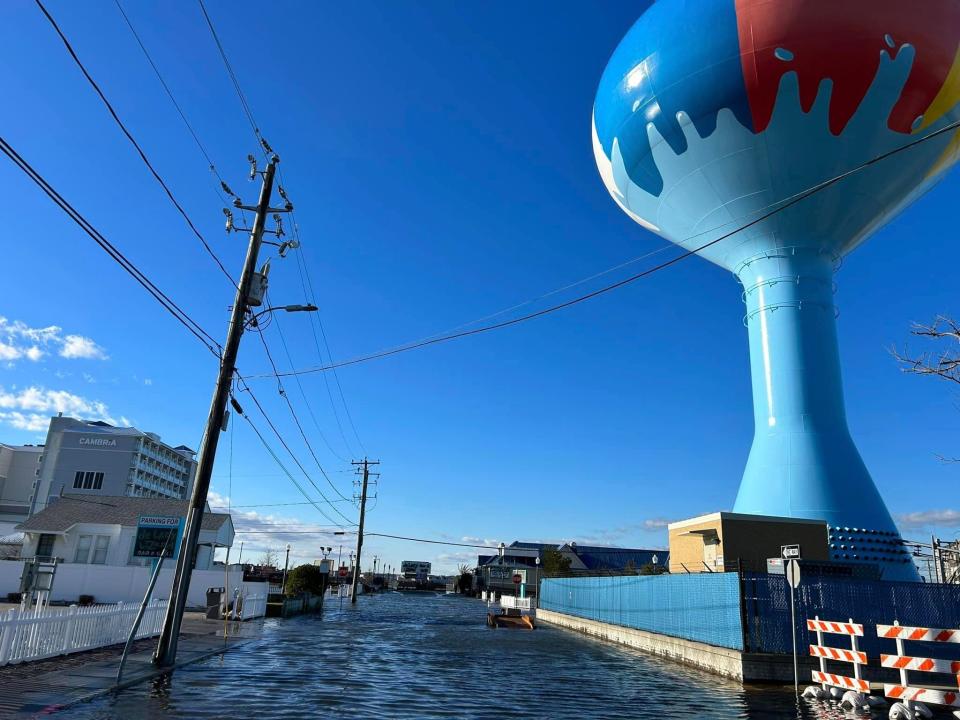Ocean City and rising seas: How resort, business owners handle the challenge
For picturesque locales like Ocean City, the views come at the risk of environmental factors like sea level rise and coastal flooding.
National Oceanic and Atmospheric Administration sea level rise projections have oceans higher by 1.6 feet in some areas on the East Coast and Mid-Atlantic by 2050. By the end of the century, that goes up to 4 feet, easily inundating large areas of the Virginia, Delaware and Maryland coastlines, including Ocean City.
"We try to have a good handle on sea level rise data, and there's a wide range of estimates and its impact," said Terry McGean, Ocean City Manager. "The one we rely on is the Army Corps of Engineers that estimates a rise of half an inch per year. I think one of the misconceptions people have is the threat is the ocean, but we have beach replenishment projects that take that into account."

McGean noted there is an annual survey of the 10-mile stretch of beaches, with 1992 being the last time there was measurable ocean flooding. The real problem is what McGean calls nuisance flooding on the bay side of the town, which he says are signs of sea level rise and climate change-related issues.
Fortunately for the residents and seasonal tourists to Ocean City, it only makes streets impassable with limited property damage.
"The bay side is all hardened structures, so when we replace a bulkhead, we build it higher," McGean said. "Our building regulations require structures not only be built to the base flood elevation, but to be built 2-3 feet above that to account for sea level rise for the life of the structure. We've dealt for impacts of ocean storms for years."
That experience has put Ocean City "ahead of the game" in terms of sea level rise threats, McGean said.
Massive waves in Ocean City: Strong gusts of wind lead to massive winter waves at Ocean City Inlet and Pier: PHOTOS
Hurricanes are occasional disturbances to Ocean City's steady business

For Susan Jones, director of the Ocean City Hotel, Motel, and Restaurant Association, weather or environmental concerns have not been a deterrent for the city's growing business portfolio.
"We have many members that are seasonal, or four to six months out of the year, and others open year-round," Jones said. "We don't follow the weather like the city's Office for Emergency Management would, but when there is a threat of hurricanes or flooding, they do reach out to me, and we alert our members. In the 28 years I've been here, there have been times when we saw (severe weather) like Hurrican Irene and Hurricane Sandy."
Jones recalled the rare evacuation order following such hurricanes making landfall, but also cited the steady growth of new businesses opening in the famed vacation spot.
"People want to be here because our three-mile boardwalk and our 10-mile beach and it's a desirable spot to do business," Jones said.
New OC museum in works: Ocean City will get museum about its Black history, including Duke Ellington, Count Basie
Steps from the Ocean, the view from a beachfront Ocean City hotel

One of those businesses hoping to cash on the visitor rush is the Hilton Ocean City Oceanfront Suites, located only steps from the shore.
In the year-and-a-half that Mark Elman, its general manager, has been in the post, he has not experienced any severe flooding at the location. That is despite NOAA's 2023 climate assessment that Louisiana, Massachusetts, Mississippi, New Hampshire and Texas each saw their warmest year on record, while Connecticut, Florida, Maine, Maryland, Vermont and Virginia each saw their second-warmest.
An additional 24 states experienced a top-10 warmest year on record.
"Typically, when we see flooding though high surf or high-water levels is during nor'easters," Elman said. "Never have I seen the dunes or the dune walkways being breached to where water was coming towards our property. For us, we pay more attention to wind and rain to the building itself. It's typically winds that cause damage through loose objects for us."
As for doomsday scenarios that place the beachfront city under ocean water by the end of the century, Elman takes a measured approach, noting projections can or cannot occur and that he believes preparedness measures are being taken by the appropriate agencies.
More on images from regional flooding Flooding photographs can be put to good use with Maryland-backed app
Snow Hill as beachfront property, Chincoteague entirely underwater?
NOAA's climate report for 2023 paints a bleak picture of the average temperatures on Earth, which leads to disappearing ice caps and higher sea levels.
Left unchecked, NOAA stipulates, much higher ocean levels could leave areas like Snow Hill as nearly oceanfront property in Maryland, with much of Chincoteague entirely underwater.
Organizations like Sea Grant Maryland are already assisting the Maryland Coastal Bays Program with a climate change vulnerability assessment and action plan. The Coastal Bays program is charged with protecting and conserving the water and surrounding land of Maryland’s five coastal bays near Ocean City and Assateague Island.
The vulnerability assessment identifies and prioritizes climate-related risks to the coastal bays, which will be used in the development of a climate action plan.
"We're seeing sea level rise for two reasons, due to thermal expansion of the oceans and freshwater ice melting," said professor Stephen Tomasetti, a global change ecologist and climate change expert at the University of Maryland Eastern Shore. "They are projected to continue to rise and the real danger comes when we look at powerful storms and storm surges. Over time, those high tides are getting higher and higher until it threatens coastal communities."
Tomasetti added such storms can temporarily raise sea levels and create dangerous conditions.
"Sea levels in the future are (contingent) on the decisions we make today and the next few decades. We give projections based on emissions scenarios, so we often hear these 'doomsday' circumstances if we don't change our emissions habits," Tomasetti said.
More on oysters in 2023 Oysters enjoy 'prolific' year all around Chesapeake Bay. Here's what to know.
This article originally appeared on Salisbury Daily Times: How Ocean City stays 'ahead of the game' with sea level rise threats

